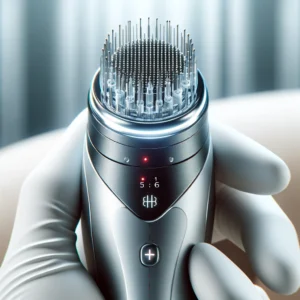Does Microneedling Work?
Microneedling, often hailed as a revolution in skincare, has garnered significant attention in the cosmetic procedure realm for its remarkable efficacy in addressing a multitude of skin concerns.
A minimally invasive treatment, it is also known as collagen induction therapy, has evolved through the years, blending ancient practices with modern scientific advancements.
Understanding Microneedling Treatment
Historical Roots and Evolution
The concept of microneedling isn't new. It finds its roots in ancient acupuncture techniques, which involved using fine needles to rejuvenate the skin.
However, the microneedling procedure as we know it today began to take shape in the 1990s. Dermatologists discovered that tiny needles could create micro injuries on the skin's surface, initiating the skin's healing process and, consequently, the natural production of collagen and elastin.

This process is known as collagen induction, a cornerstone principle in the efficacy of microneedling.
Scientific Breakthroughs and Technology
The progression of microneedling from a rudimentary needle-based practice to a highly sophisticated cosmetic procedure is a testament to its scientific development.
The introduction of automated microneedling devices, for instance, marked a significant leap in this field.
These devices, equipped with fine, tiny needles, efficiently puncture the skin's superficial layer, ensuring uniformity and precision in treatment.
This innovation not only enhanced the safety and efficacy of the procedure but also broadened its scope to treat a variety of skin concerns, including fine lines and wrinkles, acne scars, and enlarged pores.
Microneedling in Modern Dermatology
Today, microneedling stands as a preferred cosmetic treatment in many dermatologist's offices across the globe.
Board certified dermatologists often combine it with other therapies like platelet-rich plasma (PRP) or laser treatments for enhanced results.
The procedure's ability to stimulate collagen production and improve the texture of your skin without the extensive downtime associated with more aggressive treatments like chemical peels or surgery has made it a go-to option for patients seeking minimal downtime with maximal results.
Microneedling's Growing Popularity
The popularity of microneedling can also be attributed to its versatility. It caters to various skin tones and types, effectively treating issues like dark spots, acne scarring, and signs of aging skin.
Moreover, with the advent of at-home microneedling devices, the procedure has become more accessible, allowing individuals to maintain their skin rejuvenation regimen from the comfort of their homes.
In essence, the journey of microneedling from an ancient healing technique to a modern-day cosmetic procedure underscores its effectiveness and adaptability.
It stands as a testament to how traditional methods can evolve through scientific insights to become a cornerstone in contemporary skincare treatments.
As we delve deeper into the intricacies of microneedling treatment in the following sections, we'll uncover its science, benefits, and the transformative impact it holds for those grappling with various skin concerns.
The Science Behind Microneedling Therapy
Microneedling, a procedure that has gained substantial traction in the realm of cosmetic treatments, operates on a fascinating scientific principle.
Many people ask us does microneedling work, to answer this you have to understand that at its core, microneedling triggers the body's natural wound healing processes, leading to skin rejuvenation and repair.
This section delves into the intricate science behind this procedure, the role of collagen and elastin, and the clinical evidence supporting its efficacy.
Triggering the Healing Cascade
The primary mechanism of microneedling involves the creation of tiny, controlled micro-injuries to the skin using tiny needles.
This process, performed with a microneedling device, intentionally damages the stratum corneum (the outermost layer of the skin), leading the body to initiate a natural healing process.
These micro-injuries stimulate the skin's fibroblasts, cells responsible for generating connective tissue and allowing the skin to recover from injury.
Collagen and Elastin Production: The Cornerstones of Skin Repair
Upon these micro-injuries, the skin responds by ramping up the production of collagen and elastin, two vital proteins that are the building blocks of healthy, youthful skin.
Collagen provides structure and firmness, while elastin imparts elasticity. This increased production, known as collagen induction, helps in filling in fine lines and wrinkles, improving skin texture, and yielding a more youthful appearance.
The process is sometimes referred to as collagen induction therapy or percutaneous collagen induction.
Clinical Studies and Research
Numerous clinical studies have validated the effectiveness of microneedling. For instance, a study published in the Journal of Cutaneous and Aesthetic Surgery found that microneedling significantly improves skin texture and reduces the appearance of scars.
Another study in the International Journal of Dermatology highlighted its efficacy in treating acne scars, showing substantial improvement in skin appearance.
These studies underscore microneedling's role as a minimally invasive procedure that can effectively treat a range of skin concerns.

Understanding the Timeline of Skin Improvement
The healing and rejuvenation process post-microneedling is not instantaneous. Collagen production ramps up gradually, with visible improvements typically seen a few weeks after treatment.
Full effects, especially in the case of treating deeper skin scars or stretch marks, may require multiple treatments and several months to materialize fully.
Benefits of Microneedling
Revitalizing Post-Acne Scarring
Microneedling, also known as skin needling, has emerged as a beacon of hope for those grappling with post-acne scarring.
This innovative cosmetic procedure, performed by a board-certified dermatologist, employs tiny needles to create micro-injuries on the skin.
This process, while causing minor skin irritation, stimulates the skin's healing process, leading to significant improvements in the texture of acne scarring.
Minimizing Surgical and Mild Scars
Surgical scars can be a persistent reminder of past medical treatments. Microneedling offers a minimally invasive procedure to reduce the visibility of these scars.
By stimulating collagen production and skin rejuvenation, microneedling helps in smoothing out the skin, making surgical and mild scars less noticeable.
Efficacy in Treating Fine Lines and Wrinkles
One of the most celebrated microneedling benefits is its ability to treat fine lines and wrinkles, hallmarks of aging skin.
Through the induction of new collagen, this treatment aids in improving skin elasticity, thus reducing fine lines and giving the skin a more youthful appearance.
Enhancing Skin Tone and Texture
Microneedling is not only effective in treating acne scars but also in enhancing overall skin tone and texture.
It addresses uneven skin tone and enlarged pores, common skin concerns for many. The microneedling device carefully creates tiny holes in the skin, promoting a more even skin tone and refining pore size.
Addressing Cystic Acne and Raised Scars
For individuals suffering from cystic acne and raised scars, microneedling offers a ray of hope. This medical treatment, often performed in a dermatologist's office, can significantly improve the skin’s texture.
The procedure's minimal downtime makes it an attractive option for those seeking a quick return to their daily routines.
Microneedling and Collagen Induction Therapy
At its core, microneedling is a form of collagen induction therapy. It's a revolutionary approach that harnesses the body's natural collagen production mechanism.
This aspect of microneedling is crucial in treating various skin conditions, from fine lines to acne scars, by promoting skin elasticity and firmness.
Microneedling for All Skin Tones
An exceptional feature of microneedling is its suitability for all skin tones. Unlike certain laser treatments, microneedling is safe and effective for both lighter and darker skin tones.
It offers a universal solution to various skin concerns without the risk of hyperpigmentation.
A Versatile Solution for Multiple Skin Concerns
Microneedling transcends the boundaries of conventional cosmetic procedures. It addresses multiple skin concerns in one go – from acne scars to stretch marks.
It's a testament to the versatility of this minimally invasive procedure, making it a sought-after treatment in cosmetic dermatology.
Combining Microneedling with Other Treatments
Microneedling and Kybella: A Synergistic Approach
Combining microneedling with Kybella offers a multifaceted approach to skincare and rejuvenation. Kybella, primarily used for reducing submental fat (double chin), when paired with microneedling, can lead to enhanced skin texture and toning.
The microneedling procedure's ability to stimulate collagen production complements Kybella's fat reduction, resulting in a more defined jawline and smoother skin.
PRP Therapy: Amplifying Facial and Hair Rejuvenation
Platelet Rich Plasma (PRP) therapy is a natural fit with microneedling, especially in facial and hair rejuvenation treatments. PRP involves using a patient's own blood components to stimulate healing and growth.
When integrated with microneedling, the tiny needles create channels that allow deeper penetration of PRP, enhancing the skin’s healing process and stimulating hair growth. This combination is particularly effective in treating acne scars, fine lines, and promoting healthier, more vibrant skin.
Sculptra and Microneedling: A Duo for Lasting Results
Sculptra, an injectable treatment, works remarkably well alongside microneedling. Sculptra focuses on restoring facial volume and smoothing deep wrinkles.
When combined with microneedling, it not only improves skin elasticity but also aids in the even distribution of Sculptra. This synergy leads to more natural, long-lasting results, effectively addressing aging skin concerns.
Hair Transplants and Microneedling: Enhancing Hair Restoration
In the realm of hair restoration, microneedling has found its place as a complementary treatment to hair transplants. Microneedling can be used post-transplant to stimulate the scalp and enhance the growth of transplanted hair.
The process encourages blood flow and nutrient delivery to the follicles, aiding in the recovery and growth of new hair. This combination can be particularly beneficial for those undergoing hair restoration procedures at Plush Aesthetic.
Microneedling and Cosmetic Procedures: Broadening Treatment Horizons
Microneedling's versatility allows it to be combined with various cosmetic procedures. From laser treatments to chemical peels, microneedling can enhance the effectiveness of these treatments.
It prepares the skin by promoting increased absorption and responsiveness, leading to improved outcomes in addressing skin concerns like dark spots, uneven skin tone, and acne scarring.
Board Certified Dermatologist’s Role in Tailored Treatments
A board-certified dermatologist plays a crucial role in determining the right combination of treatments. At Plush Aesthetic, the expertise of dermatologists ensures that each patient receives a customized treatment plan, incorporating microneedling with other procedures, such as Kybella or PRP therapy, for optimal results.
Addressing Common Concerns & Myths
Microneedling, while gaining popularity, has its share of myths and misconceptions. It’s essential to address these to ensure potential patients have accurate information.
Myth 1: Microneedling is Extremely Painful
One common myth is that microneedling is an excruciating process. In reality, discomfort during microneedling is minimal. Most patients report only a mild prickling sensation. At Plush Aesthetic, a board-certified dermatologist ensures the procedure is performed under controlled conditions, often using a topical anesthetic to minimize discomfort.
Myth 2: Microneedling is Only for Younger Skin
Another misconception is that microneedling is exclusively beneficial for younger skin. Microneedling is effective across a range of ages.
It stimulates collagen induction, beneficial for aging skin, reducing fine lines and wrinkles, and improving skin elasticity. It's an inclusive treatment suitable for various age groups seeking skin rejuvenation.
Myth 3: Home Devices are Just as Effective
The market is flooded with at-home microneedling devices, leading some to believe they are as effective as professional treatments.
However, professional microneedling devices used by trained dermatologists, like those at Plush Aesthetic, are specifically designed for safety and efficacy.
Home devices often lack the precision and depth control of professional equipment.
Myth 4: Microneedling Results in Immediate Effects
While some patients may notice a glow immediately after treatment, the real benefits of microneedling, such as improved skin texture and tone, typically emerge after multiple treatments and over time. Collagen production and skin rejuvenation are processes that require patience and consistency.
Real Potential Side Effects and Their Prevalence
While microneedling is a safe procedure, it’s not devoid of potential side effects. Understanding these helps set realistic expectations.
Minor Skin Irritation and Redness
Immediately post-treatment, some patients might experience minor skin irritation and redness. This is a normal reaction to the tiny needles creating micro-injuries in the skin. These symptoms are usually short-lived, resolving within a few days.
Risk of Infection
Although rare, there's a slight risk of infection if the treated area isn't properly cared for post-procedure. Clinics like Plush Aesthetic provide comprehensive aftercare instructions to minimize such risks.
Temporary Skin Flaking and Dryness
Some patients may experience skin flaking and dryness as the skin heals and rejuvenates. This is typically a temporary condition and can be managed with proper moisturization and care.
Hyperpigmentation in Darker Skin Tones
There's a concern about hyperpigmentation, especially in darker skin tones. However, when performed by a skilled professional, the risk is significantly reduced. A york city-based dermatologist might use specific techniques and aftercare to prevent this in patients with darker skin tones.
Aftercare and Maintenance
Microneedling, a transformative skin rejuvenation treatment, has gained popularity for its ability to address a variety of skin concerns.
The efficacy of this procedure is not just in the treatment itself but also in the aftercare and maintenance that follows.
How one cares for their skin post-microneedling can significantly influence the results. This section delves into aftercare and maintenance, focusing on the specific needs of different individuals seeking microneedling.
Acne Scars: Healing and Ongoing Care
For those undergoing microneedling to treat acne scars, the skin's response to this minimally invasive procedure is vital.
Post-treatment, the skin is typically more sensitive and may exhibit minor skin irritation or pin-point bleeding. It's imperative to use gentle, non-irritating skincare products and to avoid direct sunlight. Using a broad-spectrum sunscreen is crucial to protect the healing skin from UV damage.
The number of microneedling sessions required for acne scars varies based on the scar's severity. Typically, a series of treatments spaced about 4-6 weeks apart is recommended for optimal results. After achieving the desired improvement, maintenance sessions every 6 months can help sustain the skin's texture and appearance.
Anti-Aging: Preserving the Youthful Glow
For individuals targeting signs of aging, such as fine lines and wrinkles on the upper lip or other facial areas, aftercare focuses on hydration and collagen stimulation.
Products rich in hyaluronic acid and growth factors can support the skin's natural healing process and enhance collagen production. Avoiding makeup for at least 24 hours post-treatment and staying hydrated are key steps in the aftercare routine.
The frequency of treatments for anti-aging purposes often involves an initial series of 3-5 sessions, followed by maintenance treatments every 6-12 months. This frequency helps stimulate and maintain new collagen production, ensuring lasting results.
Stretch Marks and Atrophic Acne Scars
Microneedling shows promising results in reducing the appearance of stretch marks and atrophic acne scars. The aftercare for these conditions involves keeping the treated area moisturized and protected from sun exposure. Using medical-grade skincare products prescribed by a dermatologist can aid in the healing process.
For stretch marks and atrophic scars, a series of 4-6 microneedling treatments, spaced 4-6 weeks apart, is usually recommended. Maintenance treatments once or twice a year can help in the ongoing management of these skin concerns.
Customized Home Care: Microneedling Devices and Routine
For those incorporating at-home microneedling into their skincare routine, using devices like automated microneedling pens or derma rollers requires adherence to proper technique and hygiene.
The needle lengths for home devices are typically shorter, focusing on superficial skin rejuvenation. Following each at-home session, applying serums that promote skin healing and collagen synthesis is beneficial.
It's important to note that at-home microneedling is generally less invasive and therefore might require more frequent sessions to achieve comparable results to professional treatments. Consulting with a board-certified dermatologist to determine the appropriate frequency and needle length for home treatments is advised.
Conclusion
In conclusion, microneedling represents a significant breakthrough in the field of dermatology and aesthetic medicine, offering a versatile and effective solution to a wide array of skin concerns. Its ability to naturally stimulate the body's collagen and elastin production makes it a powerful tool for rejuvenating and revitalizing the skin. From diminishing the appearance of acne scars and fine lines to enhancing overall skin texture and tone, microneedling has proven its efficacy time and again.
This comprehensive guide delves into every aspect of microneedling, from its historical roots and scientific basis to the diverse benefits it offers for various skin types and conditions. We've explored how microneedling works in harmony with other treatments like Kybella, PRP therapy, Sculptra, and even as a supportive treatment in hair transplants, expanding its utility and enhancing its outcomes.
Addressing common myths and concerns, we've shed light on the realities of microneedling, demystifying misconceptions and providing factual insights into what patients can genuinely expect. Understanding these aspects is crucial for anyone considering this treatment, ensuring informed decisions and realistic expectations.
The aftercare and maintenance section highlights the importance of post-treatment care, emphasizing that the success of microneedling doesn't just rely on the procedure itself but also on how the skin is treated afterwards. Tailoring aftercare according to individual needs and specific treatments is key to maximizing the benefits and sustaining the results of microneedling.
As microneedling continues to evolve and integrate with other advanced cosmetic procedures, it stands as a testament to the innovative spirit of dermatological science. Its ability to address a multitude of skin issues while offering minimal downtime keeps it at the forefront of cosmetic treatments. For those seeking a safe, effective, and minimally invasive option to rejuvenate and enhance their skin, microneedling offers a promising avenue, backed by scientific evidence and a growing track record of satisfied patients.
